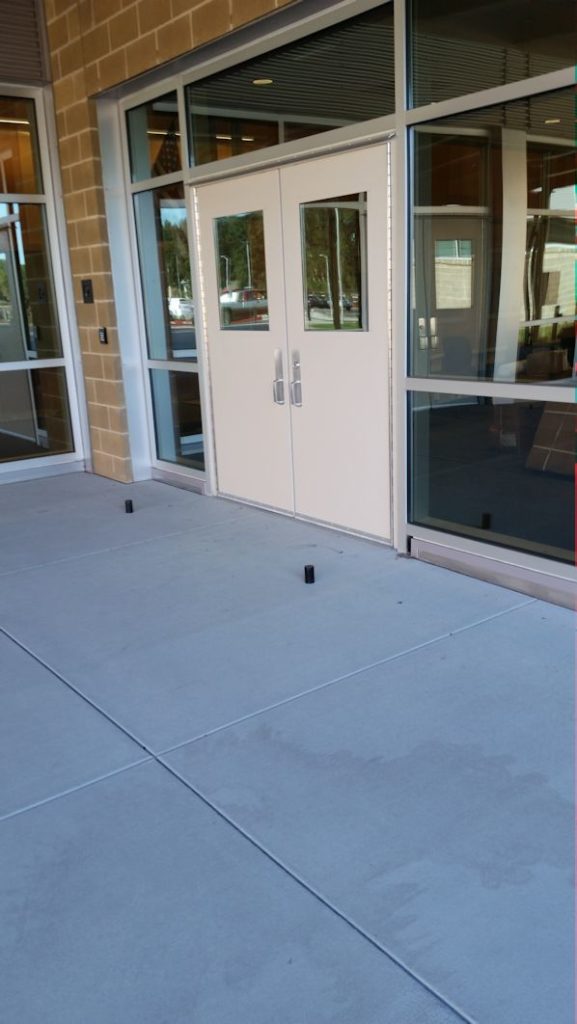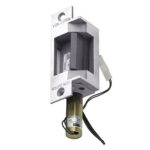I’ve posted this question every few years and I’m still looking for a good answer. Last week an architect asked whether there is guidance in the codes or standards regarding the mounting location/maximum height for floor-mounted door stops, to ensure that the stop is not a tripping hazard.
The 2010 ADA Standards limit changes in level to 1/2-inch, or the change must be accomplished by a ramp (or lift or elevator). This applies to walking surfaces on an accessible route, but how is the walking surface defined? Floor stops are used all the time, so how/where is the line drawn between acceptable locations and violations of the codes and standards?
Here are a couple of examples from Matt Wildman and Scott Stepard of Allegion:
WWYD?
You need to login or register to bookmark/favorite this content.








Eliminate the tripping hazard and take the floor height change issue out of the question by replacing the low-lying floor stop with a bollard that is visible & obvious at 36″ minimum height. With regard to ADA, Section 206, Accessible Routes, allows and acknowledges bollards as a security component:
206.8 Security Barriers. Security barriers, including but not limited to, security bollards and security check points, shall not obstruct a required accessible route or accessible means of egress.
In addition to eliminating a tripping hazard, the higher bollard provides more contact with the door and may eliminate the door and hinges from being “wracked” and damaged, as occurs when a door flexes after hitting a low object.
I see this more often than not. My question is: why can’t the floor stops be installed closer to the sidelight frame? Is it necessary that the doors dead stop at 90°?
Both of those examples look like a tripping hazard to me for anyone. I think CUSH arms on the closers would be the best solution and have no floor stops.
I don’t see anything on either of those doorways that prevents the doors from swinging 170° or so to the wall. The floor stops could be mounted there. The doors would rarely be opened that wide.
Installers often install closers without any consideration for stop function. I see this all the time.
The only obstacle I know of to a scenario like that is an auto operator. In which case, I would recommend a bollard at 110°. If the bollard is of sufficient size it’s unlikely to be tripped over.
WWYD? Well “I” would never do this. Even if there’s nothing in the code on this It’s a lawsuit waiting to happen.
The standard used in Los Angles does not concern height it does require that the stop be no more than 4” from any wall. Never have been able to get it in writing, but all the inspectors seem to know the rule
Interesting! I had not heard that one!
– Lori
Accessibility code requires that objects/features projecting from a wall do not exceed 4 inches from the surface of the wall. Floor stops would fall into that concept in my view. Hope that makes sense.
Most correct answer; use correct hardware to prevent over swinging
next best answer; put in 3 foot tall posts
I’m going to take a stab at this . My hunch is that floor stops fall within the zone of a cane sweep which picks up this type of hazard for the visually impaired. Myself, I try not to use floor stops as depicted since they are a hazard for everyone else. Would rather use an Overhead Stop.
I use common sense when scheduling stops of any sort and if the door is reverse handed (with no wall to stop the door) it does not get a floor stop.
Don’t know about code, but either example presents an obvious tripping hazard. I recommend an overhead stop like Glynn-Johnson 70S or 79S. Poor man’s version is Ives No. 115 crash stop. Some door closers like LCN Cush-N-Stop eliminate the need for a separate stop.
I say survival of the fittest!
In the Chicago area the floor stops won’t last thru the first winter (ie salt cycle). Wall stops turn into hard rocks by the second winter. Overheads or CUSH is the only solution. And greater than 90 so the selected device never actually comes into play.
Not sure why people use them. I have some old ones in my schools but there mounted tight against the wall (which is a whole another question, why not a wall stop). Anyway being 6 tall, if I’m walking along the glass and trip on the first one, the second one is right in the sweet spot (my head).
Just stop using them! They should be banned along with flat head screws!
We no longer use floor stops on the outside of our schools due mainly to vandalism.
The troublemakers go to great lengths to break off even the sturdiest brass stops.
We did try using the “Hockey Puck” style stops but they set fire to those-sigh.
As for overhead stops and cush arms, we find that in many cases these get bent or torn right out of exterior doors (Yes, even if thru-bolted!)We are now using the back-check on the closers more agressively, and specifying S-Cush arms which seem to last well.
In the case of doors with auto openers we found that when pushed open past the arm setting the arm would extend, not allowing the door to close, so those doors now get bright yellow bollards. These also seem to help with traffic flow, along with a center mullion.
FWIW: Interior floor stops tend to get destroyed by our janitors with their ride-on floor polishers (AKA -Zambonis!) so they are an issue as well.
Thanks for sharing your insight, Rich!
– Lori